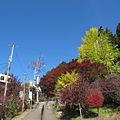User:Immanuelle/Mitsumine Shrine
| This user page or section is currently being expanded by an editor. You are welcome to help in expanding too. If this page has not been changed in several days, please remove this template. This page was last edited by Immanuelle (talk | contribs) 23 hours ago. |
| This is a draft being worked on by Immanuelle. It is too complex at the moment but she wants to get it ready to be an article someday. Others are free to edit it This page was last edited by Immanuelle (talk | contribs) 23 hours ago. |
| Immanuelle/Mitsumine Shrine | |
|---|---|
 |
| The English used in this user page may not be easy for everybody to understand. You can help Wikipedia by reading Wikipedia:How to write Simple English pages, then simplifying the page. |
Immanuelle/Mitsumine Shrine is a Beppyo shrine in Chichibu, Saitama.
It is located in the scenic heights of Okuchichibu with an elevation surpassing 1,000 meters, stands as one of the distinguished Chichibu Sanja, or the Three Shrines of Chichibu. Renowned for its spiritual ambiance and historical significance, the shrine has gained prominence as a prime "power spot" within the Kanto region. It attracts a multitude of visitors keen on experiencing its healing energies, delving into the legends of Yamato Takeru, a celebrated hero in ancient Japanese lore, and venerating Oinusama, a deity symbolized by a wolf. The presence of an 800-year-old sacred tree alongside the shrine's splendid architecture further amplifies its allure.[1]
History[change | change source]
Founding[change | change source]
The shrine's origins trace back to the first century, attributed to the founding by Prince Yamato Takeru no Mikoto, a son of the legendary twelfth emperor of Japan, Keikō. During an expedition to subdue eastern clans, Prince Yamato was captivated by the beauty of the land from a ridge he ascended. He dedicated the site to the divine Shinto creators of Japan, Izanami and Izanagi, leading to its naming by Emperor Keikō as "Mitsumine," which translates to "three peaks." This name reflects the distinctive summits of Myōhō, Shiraiwa, and Kumotori, visible to the east of the shrine.[2]
Development and Decline[change | change source]
Formal worship at Mitsumine Jinja commenced in the late seventh century with the arrival of En no Gyōja, the founder of Shugendō—a synthesis of Shinto, Daoism, Buddhism, and mountain asceticism. A significant enhancement occurred roughly a century later when Kūkai, a revered Buddhist monk, installed a statue of the Eleven-Headed Kannon within a newly constructed Buddhist hall adjacent to the shrine.[2]
The shrine experienced a surge in fame and influence during the Kamakura period, supported by yamabushi (mountain ascetics) and donations from prominent samurai patrons. However, it faced decline in 1352 after supporting Nitta Yoshioki in an uprising, leading to punitive measures from the victorious Ashikaga lords.[2]
Restoration and Modern Era[change | change source]
A pivotal restoration effort was initiated in 1502 by the Shugendō priest Gekkan Dōman, culminating in 1533 when Mitsumine Jinja was designated a regional head temple for the Tendai sect by Emperor Go-Nara. In 1720, the distribution of wolf amulets by priest Nikkō Hōin, inspired by an encounter with wolves seen as a divine omen, further enhanced the shrine's reputation in the Kantō region.[2]
The Meiji Restoration of 1868 led to the shrine's designation as a purely Shinto institution, following the separation of Buddhist and Shinto practices. The twentieth century saw various renovations and additions, including the construction of Kōunkaku lodge and a café, with significant restorations commemorating the shrine's anniversaries in 2002.[2]
Cultural and Spiritual Significance[change | change source]
Mitsumine Shrine is celebrated not only for its breathtaking location and architectural grandeur but also as a center of spiritual enrichment and cultural learning. The shrine's association with ancient legends and practices, such as those of Takeru Yamato and the worship of the wolf deity Oinusama, underscores its role in preserving and disseminating Japan's rich mythological and religious heritage. The ancient sacred tree, revered for its age and symbolic importance, adds to the shrine's mystique, embodying the continuity and deep spiritual roots of the site.[1]
As a recognized power spot, Mitsumine Shrine offers visitors a unique opportunity to connect with Japan's ancient spiritual traditions against the backdrop of the country's natural beauty. Whether drawn by faith, interest in cultural heritage, or the search for peace and healing, visitors to Mitsumine Shrine find themselves immersed in an atmosphere of serenity and profundity.[1]
Gallery[change | change source]
-
Chichibu Touryuubasi 1
-
Chichibu Touryuubasi 2
-
Chichibu Touryuubasi 3
-
Chichibu Touryuubasi 4
-
Chichibu Touryuubasi Toritukedouro 1
-
Chichibu Touryuubasi Toritukedouro 2
-
Chichibu Touryuubasi Toritukedouro 3
-
Detailed sculptures at a Shinto shrine on Mt. Kumotori
-
Kounkaku
-
Mitsumine Shrine
-
Mitsumine Shrine precinct
-
Mitsumine Shrine Haiden (Worship Hall)
-
Mitsumine Shrine Honden (Main Shrine)
-
Zuishinmon Gate at Mitsumine Shrine
-
Mitsumine Shrine in Autumn 1
-
Mitsumine Shrine in Autumn 2
-
Remote Worship Hall at Mitsumine Shrine 1
-
Auxiliary Shrines at Mitsumine Shrine
-
Prince Yamato Takeru at Mitsumine Shrine
-
Mitsumine Shrine Office
-
Torii at the Inner Shrine of Mitsumine, 2011-02-27
- ↑ 1.0 1.1 1.2 "Mitsumine Shrine | Chichibu Geopark". Chichibu Geopark | (in Japanese). 2018-12-12. Retrieved 2024-04-10.
- ↑ 2.0 2.1 2.2 2.3 2.4 "Mitsumine Jinja Shrine | Chichibu Tourism Website | Chichibu Omotenashi Tourism Organization". www.chichibu-omotenashi.com. Agence japonaise du tourisme. Retrieved 2024-04-11.





















